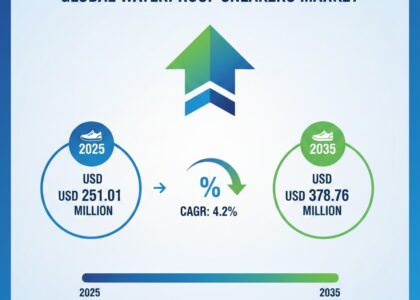The military communications market is estimated to grow from USD 52.8 billion in 2025 to grow phenomenally to USD 142.6 billion in 2035, with a CAGR of 10.3% throughout the forecast period. This growth is partly the result of increased geopolitical tensions and the demand for safe, real-time communications options intended to improve situational awareness and operational effectiveness in contemporary military operations.
In a world marked by rising geopolitical tensions, asymmetric warfare, and rapid technological shifts, the military communications market has become a cornerstone of defense strategy and national security. Reliable, secure, and real-time communication is no longer optional—it is essential for operational success across land, sea, air, cyber, and space domains.
From encrypted tactical radios to satellite-based networks and AI-powered data links, military communication systems are being reimagined to meet the demands of modern warfare and multi-domain operations.
Get Ahead with Our Report: Request Your Sample Now!
From Voice Commands to Network-Centric Warfare
Traditional communication methods centered around basic voice transmission are evolving into complex, data-rich, network-centric systems. Today’s armed forces require the ability to transmit voice, video, data, and sensor information in real time across vast distances and multiple platforms.
This transition enables enhanced situational awareness, faster decision-making, and seamless coordination between frontline units, command centers, unmanned systems, and allied forces—laying the foundation for integrated and agile defense operations.
Tactical and Strategic Communication Systems
The military communications landscape spans both tactical and strategic systems, each with distinct roles and requirements:
Tactical Communications: Focused on real-time, on-the-ground communication among soldiers, vehicles, and field command posts. These systems must be portable, rugged, and resistant to jamming or interception.
Strategic Communications: Facilitate long-distance and high-level coordination between military branches, national defense networks, and international coalitions. These systems support secure command and control through satellites, fiber-optic infrastructure, and global data centers.
Integration between tactical and strategic layers ensures unified command structures and consistent information flow across all levels of defense operations.
Emphasis on Encryption and Cybersecurity
As adversaries develop more sophisticated cyber capabilities, the need for secure communication has never been more urgent. Military communication systems now incorporate advanced encryption protocols, anti-jamming technologies, and cyber threat detection to protect data integrity and prevent interception.
This focus on cybersecurity is not limited to data links but extends to hardware, software, and satellite infrastructure—ensuring that the entire communication ecosystem is hardened against evolving threats.
Exhaustive Market Report: A Complete Study
Satellite Communication and Space-Based Networks
Satellite communications play a pivotal role in connecting forces operating in remote or hostile environments where terrestrial infrastructure is unavailable or unreliable. Military satellites enable high-bandwidth, low-latency communications for real-time video, intelligence sharing, and global troop coordination.
Emerging trends such as low Earth orbit (LEO) satellite constellations and software-defined payloads are enhancing resilience, bandwidth, and coverage—paving the way for next-generation military satellite networks.
AI, Automation, and Cognitive Radio Technologies
Artificial intelligence is beginning to reshape the military communications space. AI-powered systems can optimize network traffic, detect anomalies, and manage dynamic frequency allocation in contested environments.
Cognitive radio technology, which enables systems to automatically detect and adapt to the radio spectrum in use, is becoming vital in avoiding interference and ensuring connectivity in signal-dense or adversarial settings.
Automation is also improving speed and efficiency in setting up and managing field networks, allowing soldiers to focus on mission execution rather than manual configurations.
Joint and Coalition Interoperability
Modern conflicts often involve multinational coalitions. As a result, interoperability across communication systems is critical. Shared standards, cross-compatible encryption protocols, and secure multinational networks allow forces from different countries to coordinate seamlessly without compromising security or effectiveness.
Interoperability also extends to unmanned aerial systems, drones, and autonomous platforms, which must communicate with both domestic and allied systems for surveillance, reconnaissance, and combat support.
Mobility and Battlefield Resilience
Communication equipment must withstand extreme environmental conditions and remain functional during rapid troop movements. Portable, lightweight, and ruggedized devices are in high demand, along with vehicle-mounted and airborne systems that provide mobile connectivity in dynamic combat zones.
Redundancy and self-healing network capabilities are being built into systems to ensure operational continuity even if parts of the network are compromised or destroyed.
Logistical and Integration Challenges
Despite significant innovation, the military communications sector faces several hurdles. Integrating new technologies with legacy systems, ensuring spectrum availability, and maintaining secure supply chains for critical components remain ongoing challenges.
Budget constraints, geopolitical restrictions on technology transfer, and complex procurement cycles can also slow deployment and adoption, especially in regions with limited defense infrastructure.
Enabling the Digital Battlefield
As modern warfare grows more complex, the ability to communicate quickly, securely, and reliably across every domain is mission-critical. Military communications systems are evolving from basic signal transmission to multi-layered, intelligent networks that empower informed, real-time decision-making.
By combining secure technologies, AI-driven automation, and global connectivity, the market is equipping defense forces with the communication capabilities needed to outpace threats and maintain strategic superiority in an increasingly connected and contested world.
Catapult Your Strategy: Secure Key Insights with Our Report Checkout!
About Future Market Insights (FMI)
Future Market Insights, Inc. (ESOMAR certified, recipient of the Stevie Award, and a member of the Greater New York Chamber of Commerce) offers profound insights into the driving factors that are boosting demand in the market. FMI stands as the leading global provider of market intelligence, advisory services, consulting, and events for the Packaging, Food and Beverage, Consumer Technology, Healthcare, Industrial, and Chemicals markets. With a vast team of 400 analysts worldwide, FMI provides global, regional, and local expertise on diverse domains and industry trends across more than 110 countries.
Contact Us:
Future Market Insights Inc.
Christiana Corporate, 200 Continental Drive,
Suite 401, Newark, Delaware – 19713, USA
T: +1-845-579-5705
For Sales Enquiries: sales@futuremarketinsights.com
Website: https://www.futuremarketinsights.com
LinkedIn| Twitter| Blogs | YouTube






